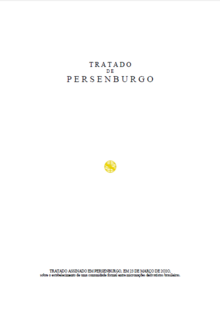Brazilian sector
| Brazilian sector | |
|---|---|
  | |
| General information | |
| Located | Brazil |
| Total population of sector | 1065[a] |
| Sector founded | 12 March 2020 (previously an integrated part of the Lusophone sector founded in 1996) |
| Membership | |
| Nations in area | 26 active micronations (out of 43) |
| Organisations in area | |
| Notable people in area | Oscar von Goëtzën Thomas de Sena Arthur van der Bruyn Lucas d'Woenstein Maria Ottokar-Flaviano Leonardo Grindi |
The Brazilian sector (Portuguese: Setor brasileiro) is a popular term to designate secessionist (Portuguese: derivatista) micronations that are mostly located or captained from within the Brazilian macronational territory. The term was coined in 2020 through the Treaty of Persenburg which aimed to establish a secessionist micronational sector for Brazilian micronationalists in opposition to the Lusophone sector dominated by simulationists. In this way, the Brazilian sector was formally established causing a rupture in the Lusophone Sector and since then it encompasses most of the secessionist micronations of Brazilian origin, with few exceptions. There are currently 26 micronations considered active members of the sector, which is greatly influenced by the largest intermicronational organization present in South America, the Conference of Santiago.
Terminology
The term "Brazilian sector" is commonly used to describe micronations of Brazilian origin that pursue the secessionist tradition, more popularly known in Portuguese as derivative (derivatista), of micronationalism, that is, the factual establishment of a macronationally unrecognized microstate as opposed to the simulationism and geofiction traditions that has developed and dominates the Lusophone sector, in which self-proclaimed micronational states emulate alternate governments of existing nation-states with fictional factoids and realize absurd territorial and population claims, when not fictional or in virtual realities.
History
Background

The first representation of micronational activity within Portuguese-speaking - or lusophone - countries emerged with the Lusophone sector, informally Lusofonia, which was de facto established in 1996[1] when the Kingdom of Porto Claro,[2] the very first both Latin and South American and lusophone micronation came into contact with other micronations. By the end of 1997, another lusophone micronation, the Holy Empire of Réunion,[3] was created and eventually surpassed Porto Claro's influence over the emerging sector, becoming the first lusophone micronation to establish intersectoral diplomatic relations.[4] Later, in 2001, the Free Community of Pasargada was founded by veterans of Réunion and became the first lusophone micronation to break from the mixed vistualist-geofictional paradigm established with Porto Claro and followed by Réunion, which was baptized "Pasargadan Realism" (Portuguese: Realismo Pasárgado), which was the first experience of secessionism among lusophone micronations.[5] However, by then, there were no clear boundaries regarding the micronational practice yet. Notwithstanding, from 2002 onwards, the example of Pasargada started to exert a huge influence within the growing lusophone sector.
The lusophone sector experienced its peak of activity between 2000 and 2005, with dozens of secessionist, simulationist and geofictional states, all adopting the micronational terminology as an umbrella term due to the absence of clear boundaries to diferentiate the practices. By circa 2006 most lusophone micronationalists, who adhered to the practice in their teenage years, had become adults enrolled with their proffessional lives and, lacking enthusiasm, among other things, let the sector into a declining era, with activity falling untils the early 2010, when the sector's vigor was restored with the establishment of several simulationist states coupled with a few seccessionist ones and some hybrid, among which the most notable was the United Provinces of Mauritia, whose many members included veterans of Pasargada and Réunion. Nonetheless, by 2020 few states remained active, the vast majority of them simulationists adherent to a hybrid practice with geofiction locally called historical-modelism, which consists of simulating alternative regimes of existing sovereign nations, such as the "German Empire" or the "United Kingdom of Portugal and Algarves". Many of these historical-modelist projects, self-identified as micronationalist, make territorial claims over parts or entire countries, and historically, therefore, maintain a hostile stance towards secessionist states, which claim small territories, usually controlled by members involved in the micronational government - territory that historical-modelists recognize as part of their claims. The frequency and sometimes the extremity of these conflicts eventually led the secessionists to unite in order to create a homogeneous space in which they could exercise their micronational practice free from pressure.
Split from the Lusophone sector

From late 2019 to early 2020, traditional lusophone (mostly Brazilian) simulationists, historical-modeslists, but also some simulationist-aligned micronationalists, grew on exposing criticism at the secessionist micronational practice in retaliation for secessionists' clomplaints that they were free to claim their private properties as micronations, regardless of the simulationists' wider claims on vast territories they did not control, but pretended they did. This clash helped greatly to define the interpretation of micronational practice by Brazilian micronationalists, aligning them with the general global interpretation, and differentiating it from simulationism, geofiction and others. As a direct result, the simulationists led a campaign of smear, coercion and embarassment against many secessionist micronationalists, even on personal level.
Seeking a friendly space for Brazilian secessionist micronationalism, free from the conflicts and rivalries that dominated the Lusophone sector, secessionist micronationalists came together in order to coordinate their actions to, among other things, escape the isolation to which the Lusophone sector was relegated, with their practice simulationist that has become almost universally recognized as apart from micronationalism. Dissident secessionists from the Portuguese-speaking sector became targets and were ostracized or often coerced into joining simulationist and historical-modelist projects. Faced with this scenario, secessionist micronationalists noted the need to form their own, homogeneous sector, and took geographic location and cultural proximity as a basis, rather than language.
Treaty of Persenburg
The factual split between the Brazilian micronationalists and simulationists, however, began with a private conversation between the Emperor Oscar I of Karnia-Ruthenia and the Queen Marina I of Manso on 12 March 2020, in which the national leaders of what were identified at the time as the most successful secessionist micronations of Brazilian origin agreed to assume a uniform position to fight the ostracism of secessionism in the Brazilian micronational scenario. To that end, they invited representatives of Brazilian-originated micronation with which their countries maintained formal relations to a online meeting on which the Treaty of Persenburg, a charter setting the boundaries between micronationalism and simulationism, was presented. The treaty also formally established the Brazilian sector as a secessionist-only sector.
However, despite having initially assented to the content of the treaty, Queen Marima I changed Manso's position regarding non-recognition and the tacit prohibition of establishing diplomatic relations with simulationist and historical-model projects (which, as they were not considered micronations by the treaty, were outside the limits of the diplomacy of ratifying countries). The monarch formally removed Manso from the Brazilian sector and did not ratify the Treaty of Persenburg, in which she was followed by the governments of Montevert and Deltaria. Despite this, the treaty moved forward with the other original signatories and the eventual accession of other micronational governments. The creation of the Brazilian sector, and the eventual founding of its first intermicronational organization, the Conference of Santiago, dedicated to the promotion of secessionist micronationalism, led many micronationalists to emerge from simulationist projects, founding their own secessionist micronations and identifying themselves with the Brazilian sector or seeking to join Brazilian micronations of sectoral and intersectoral relevance. Due to this, many micronations of the Brazilian sector are very young and emerged roughly in the same period of time.
Events and summits
The Treaty of Persenburg, in its clauses, envisages micronational meetings as part of the secessionist micronational culture and therefore encourages the holding of these meetings and intermicronational events both physically and in person as well as online. Many encounters between micronationalists who identify with the Brazilian sector preceded the formation of the sector itself. However, an emblematic meeting took place a few days before the official foundation of the sector, in the city of São Paulo, between the Emperor Oscar I of Karnia-Ruthenia and King Raphael I of Luna, on 8 March 2020. The state dinner held between the two monarchs was important to solidify the Karno-Ruthenian Emperor's conviction of the need to a split between secessionists and simulationists from the former lusophone sector, as well as the need for articulation between secessionist micronationalists in order to propagate their micronational culture. The event was considered the first micronationalist meeting in the sector.
Since then, many other micronational meetings have taken place, mainly online due to the COVID-19 pandemic, distances and costs of holding face-to-face events. The creation of the Conference of Santiago (CS) proved to be important for the participation of Brazilian-originated micronations in micronational meetings and international events. In 2022 the CS became the first South American [and Brazilian] originated group of micronations to be represented at the MicroCon, the largest and most important intermicronational event in the world. The next year, Karnia-Ruthenia became the very first Brazilian micronation, as well as Latin American and South American, to participate in the MicroCon (see MicroCon 2023). Other relevant events and meetings since the founding of the Brazilian sector include the 2021 ASAM Radiator summit with the chairs of the Grand Unified Micronational and the former Association of South Asian Micronations (ASAM), the realization of the Protocol of Quinta Velha with the ASAM and the Treaty of Blauberga with MicroFrancophonie, and the publication of the Almanac of Vetrolin, a compendium with some of the main royal and noble houses of global micronationalism.
Relations and power
Of the 26 active micronations in the Brazilian sector, 16 are member states of the Conference of Santiago (CS), which is often seen as a legitimate interlocutor and representative of the sector, despite the fact that the organization is not regional and that some states in the sector have not even had contact with it. Consequentially, the CS exerts great influence and has a large participation in the sector's activities. Until late 2022 micronations in the sector with intersectoral diplomatic networks, or international, in the macronational sense, were few. However, as of early 2024, they are already the majority, with few micronations in the Brazilian sector de facto maintaining isolationist or strictly intrasectoral policies.
These developments experienced by Brazilian-originated micronations since the establishment of the sector, added to the historical value, led to the spontaneous emergence of a hierarchy of influence and relevance, and consequently of power, within the sector. Considering factors such as political activity, stability, intermicronational prestige, vastness and depth of the diplomatic network, and a micronation's influence on others, including outside its native sector, it is often understood that Karnia-Ruthenia is the only superpower of the Brazilian sector. Micronations such as Ebenthal and Mauritia are interpreted as great powers, while Quinta Velha and Sildavia are identified like [either great or emerging powers. Braspor, Villa Alicia and Forestia fill the role of middle powers, while Nossia and Lifréia are commonly seen as small powers. Other micronations, such as Pannonia, New Southern Rhine and Mecklewmburg-Wladir are further considered as puppet, client or satellite states of other powers.
Nevertheless, some micronations such as , Barvinia, Roranhon and Tarumã have had little to no contact with other micronations in the Brazilian sector and adopt foreign policies that are often interpreted as isolationist. Finally, some former states that were part of the sector and withdrew, such as Deltaria and Manso, are widely considered patriam non grata by a sizeable part of micronations in the sector due to conflicts such as the Santiago-Mansean Conflict.
Micronations inside the Brazilian sector
Active micronations
Former or inactive micronations
| Flag | Micronation | Capital | Government | Year of establishment | Notes |
|---|---|---|---|---|---|

|
Nuremberg Commune | Holzbank-Stadtpark | One-party republic | 2020 | Inactive since 2021. |

|
Alegres | Absolute Monarchy | 2020 | First micronation to join after the signature of the Treaty of Persenburg. | |

|
Kingdom of Eminia | Thieux-en-Saint Théoton | Popular constitutional monarchy | 2020 | Formally annexed by Karnia-Ruthenia. |

|
Deltaria | Vitorinople | Constitutional monarchy | 2015 | Original co-founder. Never ratified the Treaty of Persenburg. Ceased relations with members of the sector. |

|
Kingdom of Manso | City of Manso | Constitutional monarchy | 2017 | Original co-founder. Never ratified the Treaty of Persenburg. Ceased relations with members of the sector. |

|
Schneeblutig | Peterstaad | Constitutional monarchy | 2014 | Inactive since 2020. |

|
Roschfallen | Triunphus | Absolute monarchy | 2014 | Dissolved in 2022. |

|
Pommerland | Zerbisti | Absolute monarchy | 2022 | Dissolved in 2022. |

|
Lateran State | St. Rita | Parliamentary republic | 2020 | Dissolved in 2022. |

|
Columbia | Albany | Parliamentary monarchy | 2021 | Dissolved in 2022. |

|
Republic of ValeVRG | Peperonus | Mestarism | 2022 | Dissolved in 2023. |

|
Harram | Harram | Unitary abolute monarchy | 2009 | Annexed by Ebenthal in 2023. |

|
Socialist Soviet Empire | Trotskygrad | Unitary troskyist one-party state under absolute monarchy | 2020 | Inactive since 2022. |

|
Xingu | Western Concórdia | Unitary aristocratic republic | 2022 | Originally founded as the Principality of Gardenland in 2020. |

|
State of Tarumã | Consular parliamentary republic | 2020 | Inactive since 2020 | |

|
Roranhon | Casmania Rodrigania | Autocratic constitutional monarchy | 2021 | Inactive since 2022 |

|
Union of the Soviet Socialist Republics of Legalia | Kosyngrad | One-party socialist republic | 2021 |
See also
Notes
- ↑ Added population of active micronations as of January 2024, excluding Armatia and Colvarassia.
References
- ↑ "Lusophone sector" Published in 14 December 2012. Retrieved in 15 December 2022.
- ↑ "História", Porto Claro official website. Published in 19 April 2010. Retrieved on 15 December 2022.
- ↑ Holy Empire of Réunion official website. Retrieved in 15 December 2022.
- ↑ "Hemeroteca Imperial", Imperial Gallery. Retrieved in 15 December 2022.
- ↑ Free Community of Pasargada official website. Retrieved in 15 December 2022.



























